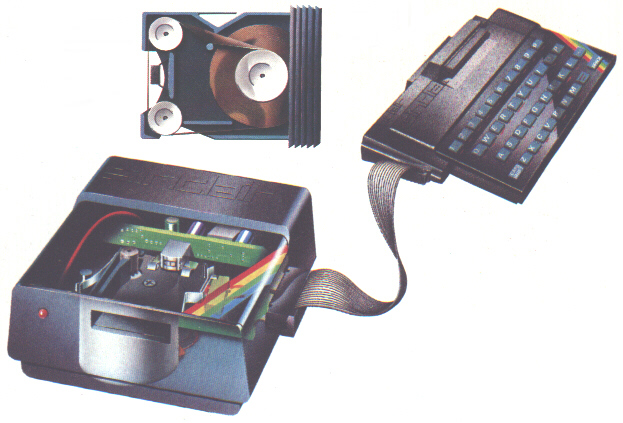Tape Storage For the home computer user the conventional cassette offers a cheap and generally reliable method of storing programs or loading comercial software. However, the cassette system does have several drawbacks. The main problem is that o speed; even a fast cassette system that operates at 1,200 bits per second can take several minutes to load a large program or search for a particular piece of data. The second major problem is that the tape moves only one way - the computer cannot usually operate the fast forward or rewind controls. If the program is at the end of the tape then the entire tape must be wound through the recorder before loading can begin. A disk system solves all these problems, but at a price. What many home computer users really need is something that is many times faster than a cassettes but much cheaper than a disk. Such devices exist and are known as 'floppy tapes' or 'stringy floppies'. Originally developed in America for Tandy's TRS-80 Model 1 system by Exactron, the first stringly-floppy used a continuous loop of tape in a cartridge housing; the idea was borrowed from the eight track audio tape system that was fashionable some years ago. The principle of operation is simple; the tape loop circulates constantly, so the various programs can be found much more quickly. A catalogue of all the programs and files stored on tape is also kept (just like the directory on a disk), so a list of the contents is always available. Because the information is recorded digitally rather than by audio methods, the transfer of information can be much faster than with an audio cassette tape - at least five times as fast, and often more. No complicated and expensive interfacing is required: the unit uses a normal parallel port and all the necessery operating software is either built into the drive or comes as a ROM to be plugged into a spare socket inside the computer. The name given to these drives describes their halfway status between a tape and a floppy disk - they use tape but operate like a disk.
Unfortunately, the first units were beset with problems. The mechanisms worked well but the tapes themselves proved unreliable. The major failing was the tape simply couldn't take the strain of being constanly pulled out of the middle of a coil and wound back on the inside. This was not a problem with eight track audio tapes as they were much wider and moved far more slowly. Very few versions of the original stringy-floppy reached the UK; one was produced by a company called Aculab but it suffered from tape quality problems. Until the introduction of Sinclair's Microdrive the floppy tape system was regarded as something of a lost cause. The principles behind the Microdrive are just the same; a loop of tape is constantly rotated past a record and replay head. Furthermore, the tape is smaller than ever, at about 2mm in width, under half as wide as the original floppy tape. Its reliability, however, is yet to be proven. |
| [ Main Page ] [ Features ] |
